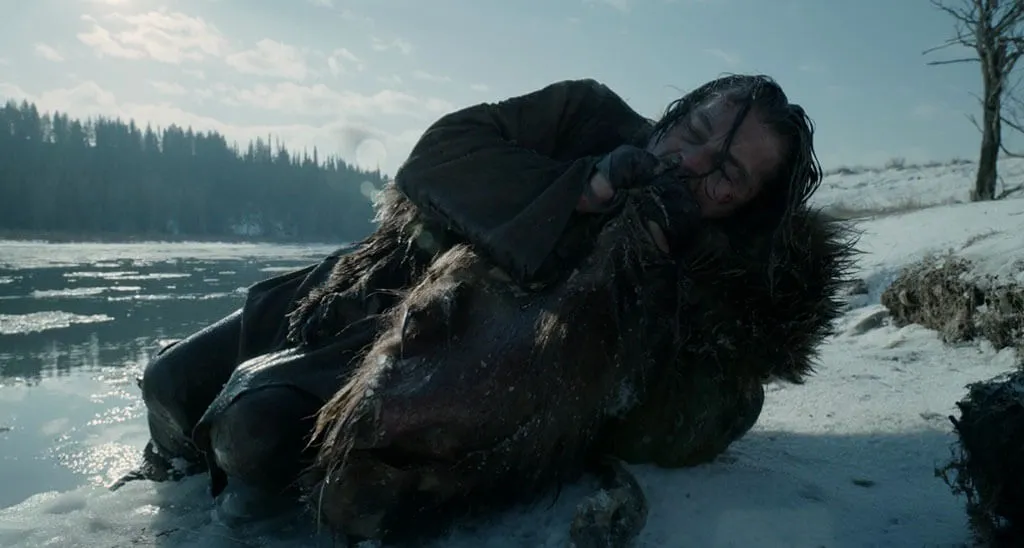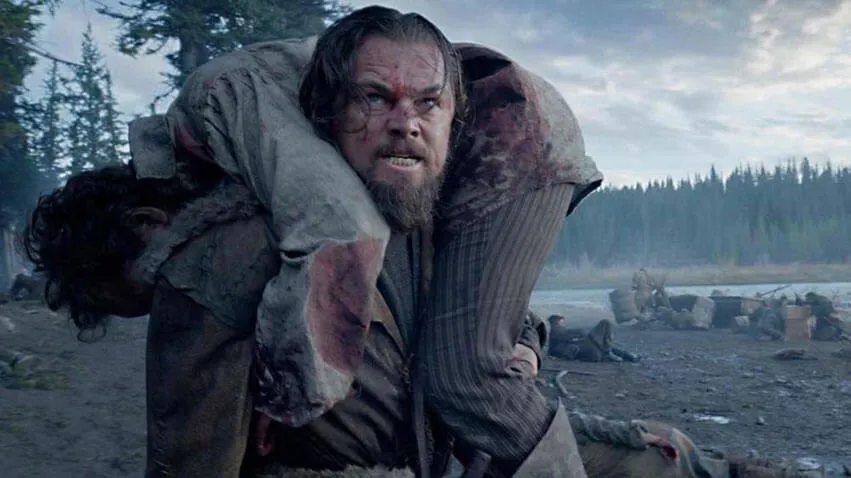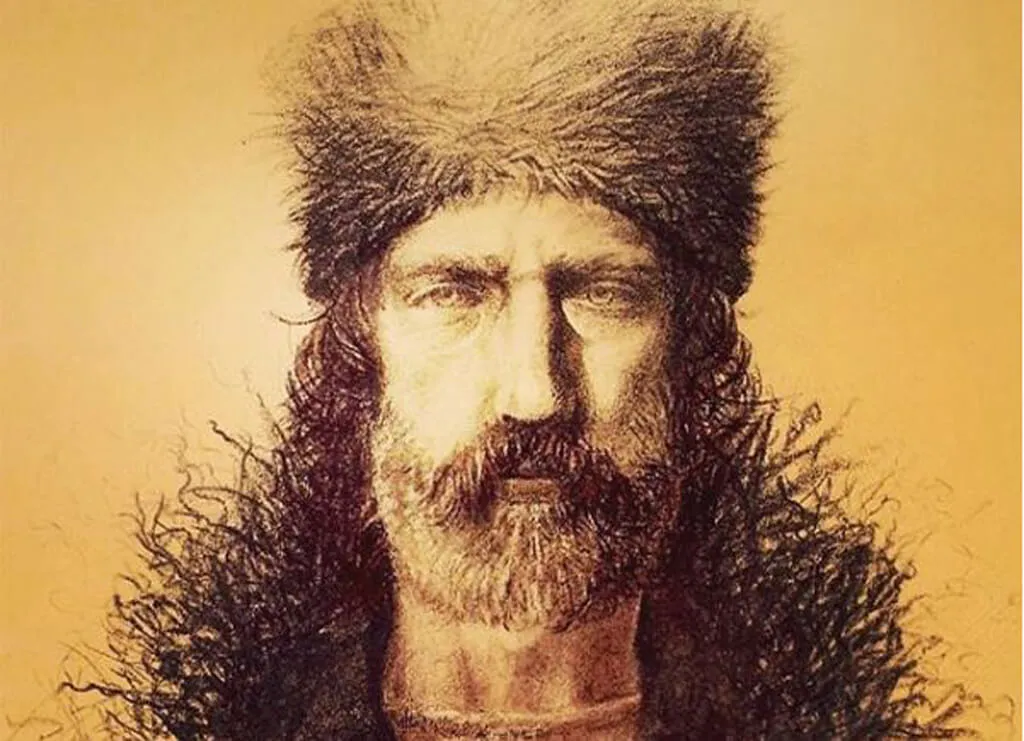The True Story Of Hugh Glass, The Man Who Inspired The Revenant
A man survives a gruesome grizzly bear attack and is left for dead by his comrades in the wilderness of the midwestern United States. He survives only by his will to live and desire for revenge against those who abandoned him. After crawling thousands of miles on the brink of death, suffering through numerous Indian assaults, and doing whatever it takes to stay alive, he survives. While this may sound like something that was concocted in a Hollywood studio for the film The Revenant, it's based on the story of American frontiersman Hugh Glass. Read about the man who inspired the award-winning movie, and discover the power of the human spirit.
Hugh Glass' Eventful Early Life
Hugh Glass was born to Scotch-Irish immigrants near Scranton, Pennsylvania in 1783. As a young man, he was a sailor until his ship was captured by the infamous pirate Jean Lafitte near the Gulf of Mexico. Glass was given a choice to either die or join Lafitte's crew. Glass decided to live, and spent the next two years working as a pirate under Lafitte.
Eventually, he escaped by jumping off the ship and swimming until he reached the coast of Galveston, Texas. However, it wasn't long until he was captured by some Pawnee Indians that he ended up living with for several years, even marrying a woman in the tribe.
Setting Off On A Doomed Mission
In 1822, Glass signed up for a fur-trading mission to become one of 100 men to travel up the Missouri river. The goal was to trade with the Native American tribes in the area and Glass' time with the Indians made him a valuable asset. Known as "Ashley's Hundred," the group made it all the way up to the Grand River in what is now modern-day South Dakota.
It was here that a mother grizzly bear horrifically mauled Glass. While Glass was alive, the bear ripped off chunks of his flesh and fed it to her cubs as Glass screamed for his group. Miraculously, Glass managed to kill the bear. When he was found, his body was hopelessly mangled.
Left For Dead

Although Glass did not die from the attack, the rest of the men knew that he did not have long to live. Because he was so badly injured, there was no way that they would be able to carry him to safety. With winter approaching and the high threat of an Indian attack, the rest of the group needed to get out of the wilderness as soon as possible.
They offered a man named Fitzgerald and a boy named Jim Bridger money to stay behind with Glass until he died. After five days, the two men abandoned Glass and took all of his belongings, including his beloved rifle. The weapon would have been essential for wilderness survival. The men caught up to the Ashley's Hundred group and gave the items as proof of Glass' death.
Alone In The Wilderness

When Glass regained consciousness, he was alone and on the brink of death. It is written that "his rage at being abandoned provided him with the vitalizing will to live." He couldn't have been in worse condition, having one broken leg and infected lacerations all over his body, with cuts so deep they exposed his ribs and other bones.
From his knowledge of the wilderness, he figured that he was around 100 miles from the nearest post, Fort Kiowa. Fueled by revenge, he began to crawl through the wilderness. He ate raw meat from animal carcasses and edible berries and roots. Slowly, he began to regain his strength.
Help From The Sioux

As time passed, Glass stopped crawling to focus on regaining his strength and cleaning his maggot-infested wounds. Unfortunately, he could not clean the wounds on his back which became so infected that they were life-threatening.
As his wounds began to scab over, Glass headed out into the wilderness once again, only this time, on his two feet. During his travels, he came upon a tribe of Sioux who took him in. They helped clean the wounds on his back and cared for him until he was ready to make the rest of the journey to Fort Kiowa.
Another Stroke Of Bad Luck

After miraculously making it to the fort, Glass told the story of his betrayal and spent a few days recuperating from his incredible journey. It was here that he joined a trapping team at Fort Kiowa on their way to Yellowstone. This would put him closer to Fort Henry, where the men from his original fur trapping expedition had been headed.
He was given a free weapon and ride in order to exact his revenge on those who abandoned him. However, during their travels, they were attacked by a group of Aricaras Indians. During the battle, the trappers were aided by a tribe of Mandan Indians but to no avail. Every member of the trapping party except for Glass had been killed.
Not Ready To Give Up

Barely escaping with his life, Glass was still determined to reach Fort Henry to come face-to-face with Fitzgerald and Bridger. He traveled to Fort Tilton which was manned by The Columbian Trading Company, a small fort located between the friendly Mandan and violent Aricaras.
The traders were in disbelief when Glass to them him his story. They told him if he wanted to go any farther, his best option was traveling on the east side of the river where he was less likely to run into Aricaras. They told him the best they could do was offer him a ferry across the river which he accepted.
On His Own Once Again

From there it was 250 miles upriver to reach Fort Henry. This was the true test of Glass' survival skills in dealing with arctic winds and starvation. After over a month of grueling traveling and survival, he finally reached Fort Henry. To his dismay, he discovered that the fort had been deserted. While at the fort, he learned that the group had headed south up the Yellowstone and Glass was on the hunt once again.
At the end of 1823, Glass reached a new outpost at the mouth of the Bighorn River. Here he found his original fur trapping group, including young Jim Bridger who was in shock upon seeing him. Luckily for Bridger, Glass found it in his heart to forgive the young boy who didn't know what he was doing and had been convinced by Fitzgerald to abandon him.
Fitzgerald Was Nowhere To Be Found

To Glass' dismay, he learned that Fitzgerald had left. He had left for the mountains and floated down the Missouri River as Glass was making his way up towards Fort Henry. It was believed that Fitzgerald was making his way to Fort Atkinson along with Glass' precious rifle. It wasn't long before Glass was on his trail, along with a few other volunteers.
Unfortunately, the group stumbled across another band of hostile Indians in which a few were killed and the others went missing. Glass was alone in the wilderness once again, with 400 miles to go. Finally, Glass reached Fort Atkinson where he demanded Fitzgerald's head.
He Would Not Have His Revenge

Fitzgerald was indeed at the fort. However, he had enlisted for the Army in April, and the Army declined to let a civilian execute a soldier. Disappointed, Glass was still thankful to have shamed Fitzgerald, lived, and retrieved his lost belongings, including his cherished rifle.
Glass went on to join a trapping party heading for Santa Fe and continued to work as an independent trapper for nine more years. He worked and lived on his own accord. Then, in 1833, Glass' luck finally ran out, and he was killed by a group of Arikaras who rode away with his precious rifle.
Hugh Glass's Story Has Inspired Many

John Lopez / Twitter
Hugh Glass passed away in 1833 at the age of 50. While he may have succumbed to the Arikaras, his story inspired many, and his legacy lives on to this day. Glass's heroic journey truly tested how far one many could be pushed, and shows that sometimes, the will to live can help us overcome even the most diabolical circumstances.
Today, a monument to Glass stands near the site of where he was mauled on the southern shore of the Shadehill Reservoir in Perkins County, South Dakota, right at the forks of the Grand River. In addition to the monument, Glass's life has inspired books, documentaries, and films, including the award-winning movie The Revenant.
Development for The Revenant Began In 2001

The Revenant hit theaters on Christmas Day 2015, but production for the film started in 2001 and was anything but streamlined. Producer Akiva Goldsman acquired the rights to Michael Punke’s unpublished manuscript in August of that year. The script, which was written by David Rabe, was passed around, landing in the hands of director Park Chan-wook.
After Park left the project, development stalled for nearly nine years. In that time, the script was adapted for another entertainment company, and passed from director to director, until finally, Alejandro G. Iñárritu took the reigns.
Leonardo DiCaprio Wasn’t Always Going to Play Hugh Glass

Because the production of The Revenant took well over a decade and was passed from director to director, numerous Hollywood A-listers were considered for the role. When director Park Chan-wook was heading the film, he had Samuel L. Jackson in mind to star. When director John Hillcoat took over production, he was negotiating with Christian Bale.
Alejandro G. Iñárritu finally agreed to direct the film in August 2011 — 10 years after production initially began — and knew he wanted to have Leo head the film.
Depicting Glass’s Story Proved To Be a Challenge

Filming The Revenant proved to be difficult for numerous reasons. While working on rewriting the script, the cast and crew had significant doubts that they would be able to pull off filming some of the sequences. In an interview with Creative Screenwriting, writer Mark L. Smith said, "He [Iñárritu] would have some ideas and I would say, 'Alejandro, we can’t pull the filmings off. It’s not going to work,' and he would say, 'Mark, trust me, we can do this.' In the end, he was right."
Another challenge the team was presented with was dwindling daylight. Since Iñárritu filmed the movie using natural lighting in a remote location, the cast and crew had to work quickly. In an interview with Deadline, Iñárritu said, "Shooting in such remote far-away locations that, by the time we arrive and have to return, we have already spent 40% of the day."
The Revenant Was Shot In Three Countries

Filming The Revenant was a huge undertaking, and production spanned three countries. Production began in the United States and took place in both Canada and even Argentina. While in Canada, the cast and crew worked in Calgary and Fortress Mountain in Alberta.
They also filmed certain scenes at the Badlands near Drumheller and at Squamish and Mammoth Studio in British Columbia. While filming in the United States, production primarily took place in Libby, Montana.
A Snow-Free Canada Brought the Cast and Crew 9,000 Miles Away[caption caption="Perito Moreno glacier, Los Glaciares national park, (UNESCO World Heritage List, 1981), Santa Cruz, Patagonia, Argentina." align="alignnone" id="attachment_139952" width="1024"][/caption]

The Revenant was initially intended to be filmed entirely in Canada, but the weather had other ideas. High temperatures and rapid snowmelt led the filmmakers to alternative locations — specifically Rio Olivia, which is near the tip of Argentina and was sure to have snow on the ground.
This change in plans was significant for the cast and the crew. Moving from the originally Canadian location to Argentina was nearly 9,000 miles away according to The Guardian.
The Filming Conditions Were So Tough, Lots of People Quit

It’s safe to say the conditions while filming The Revenant were tough. For months on end, the cast and crew had to work in frigid conditions that weren’t always safe. Lots of crew members ended up quitting during production. While Leonardo DiCaprio never threw in the towel, he did detail how difficult filming was.
Dicaprio told Yahoo, "I can name 30 or 40 sequences that were some of the most difficult things I’ve ever had to do. Whether it’s going in and out of frozen rivers, or sleeping in animal carcasses, or what I ate on set. [I was] enduring freezing cold and possible hypothermia constantly."
How They Filmed the Bear Attack

Leonardo DiCaprio is one of the most celebrated actors of our time. He’s been in a slew on dynamic roles and has always managed to make them memorable. But arguably one of his most impressive scenes to date was the bear attack in The Revenant. The gruesome scene looks painstakingly real and left audiences everywhere wondering how they managed to film the shot.
In 2015, DiCaprio detailed some trade secrets to Yahoo, saying, “It involved me flying around the forest, and it involved a tremendous amount of rehearsal. And it was pretty agonizing to do.” DiCaprio added, “[Those scenes] — amongst many other sequences — were some of the more difficult things I’ve ever had to do in my entire career. But the end result is going to be one of the most immersive experiences audiences will ever have with what it would be like to come face-to-face with an animal of that magnitude that is incredibly primal.”
The Grizzly Attack Depicted In The Revenant Is Very Accurate

While Leonardo DiCaprio didn’t dish on the details of how they filmed the scene, he did say it was one of the hardest scenes he’s filmed during his acting career. Luckily, his hard work paid off. The bear attack scene is regarded by historians as highly accurate.
Still, there are a few details that differed from reality. In real life, Hugh Glass made a futile attempt to climb a tree before the bear began mauling him. He also was able to shoot at (and successfully hit) the bear early on, which wounded the bear but wasn’t enough to kill the creature. Although these two facts were omitted from The Revenant, the scene is largely accurate, which makes it all the more gruesome.
What The Revenant Got Wrong

It’s safe to say that The Revenant isn’t the easiest movie to watch. Watching Leonardo DiCaprio portray Hugh Glass trying to survive a brutal attack by a grizzly bear and then fight for his life in the frigid winter left many viewers hoping he would die simply so he could be free of suffering.
But while the cast and crew of The Revenant worked tirelessly to ensure the movie was as accurate as possible, they still didn’t get everything right. From Glass’s family to when he completed his journey, check out a few of the things The Revenant got wrong.
Glass Made His Journey In Late Summer

One of the reasons The Revenant is so intense is because of the harsh elements. The movie was filmed in the northern United States, Canada, and the tip of Argentina during the winter months.
While it is true that Glass and his men faced harsh environmental conditions, they likely weren’t as intense as depicted in the film. In reality, Glass’ infamous bear attack occurred in August of 1823. At this time the weather was still mild. Obviously, crawling through the forest to survive is tough in any sense, but Glass didn’t do so in the snow.
He May Not Have Even Had a Wife or Child

Some speculate that Hugh Glass had a Native American wife or girlfriend with whom he also had a son. In reality, there is no evidence to support these claims. Before his epic struggle to survive took place, Glass lived out his days in Pennsylvania. Some believe he may have had a wide and two sons during this time but eventually abandoned them.
Regarding the movie, The Guardian wrote, “The backstory about Glass’s love for a Pawnee woman is fiction. It has been suggested the real Glass had such a relationship, but there’s no firm evidence—and no evidence that he had any children. ... As for the ending, it has been changed in one significant way: in real life, nobody got killed."
Hugh Glass’s Route Was Different In Real Life

In The Revenant, the film shows Glass crawling while he tries to catch up with the group of men who abandoned him to die. This makes for a compelling story, but in real life, Glass crawled in the opposite direction of the men. Instead, he crawled nearly 300 miles to Fort Kiowa first, then returned back to the trail to find the men who betrayed him.
It wasn’t until two months after the attack that Glass joined Charbonneau on his ill-fated expedition to the Mandan villages.
Hugh Glass Never Tried to Kill Fitzgerald

In The Revenant, Hugh Glass attempts to kill Fitzgerald, but in reality, this wasn't the case. Instead, Glass gave Bridger because he was young and because Fitzgerald had provoked him to leave Glass. The next June, Glass was able to catch up with Fitzgerald, but the fort commander had a warning for him.
The fort commander warned that if he harmed Fitzgerald, he would suffer the consequences, and if he killed him, he would be killed in return.
The Arikara Attack On Glass Was Different In Real Life

While the Arikaras did kill Glass, the events didn't unfold exactly as they did in the movie. In reality, the Arikaras didn't catch up with him while he was trying to get to Fort Kiowa. Instead, they tried to kill him three different times. The first time was when they attacked Ashley and the group of trapped in the summer of 1823.
The next attack came when Glass joined Charbonneau. The Arikaras managed to kill five men associated with Glass and Charbonneau, but they escaped. The Arikaras finally killed Glass 10 years after he was attacked by the grizzly.
No Army Ever Slaughtered a Pawnee Village

In The Revenant, the film shows Hugh Glass’s wife being murdered. But in reality, no white army every slaughtered a Pawnee village. The Pawnees actually sided with the white man against the Sioux's, the Comanches, and the Cheyennes — all of whom were their long-time enemies. The Pawnees also never declared war on the United States, even though other tribes did.
Despite the inaccuracies, director Alejandro G. Iñárritu kept accuracy at utmost priority. He even worked with a team of cultural consultants and linguists to ensure the dialogue was correct.
Accuracy Was Iñárritu’s Biggest Priority

Accuracy was one of director Alejandro G. Iñárritu’s biggest priorities. To ensure The Revenant was as accurate as possible, he hired several cultural consultants as well as two linguists to help with the script. By working with these individuals, the writers crafted lines for the actors and actresses that were true to the Arikara and Pawnee language.
For its writing, The Revenant has been highly praised.
The Hard Work of the Cast and Crew Paid Off

The Revenant was one of the biggest movies of the year when it was released in late 2015. The film went on to receive numerous awards, most notably for Iñárritu's direction, Lubezki's cinematography, and DiCaprio’s acting.
For the film, Iñárritu was the Best Director award, while Lubezki won the award for Best Cinematography. Finally, DiCaprio won for Best Actor. The film won three awards at the 73rd Golden Globes and received an incredible 12 Academy Award nomination — the most of any film at the ceremony.
The Reason Behind The Movie's Name

In The Revenant, there is no explanation of what the term 'revenant' actually means. A revenant is a ghost —exactly what Bridger thought Glass was when he arrived at Fort Henry.
Legend has it that Bridger was overcome with guilt about leaving Glass to die that he thought Glass's ghost was actually haunting him when he saw him again since he figured it was impossible for him to still be alive.
Hugh Glass Appears In World of Warcraft

Believe it or not, Hugh Glass actually inspired a level in the online video game World of Warcraft. Hugh Glass can be found in level 75 of the game, where he is a quest giver (put simply, a non-player character that assigns quests for players) who appears to have gone insane.
His character in the video game is found living in Redwood Trading Post. Funny enough, he lives with him companion Griselda, who happens to be a grizzly bear.











